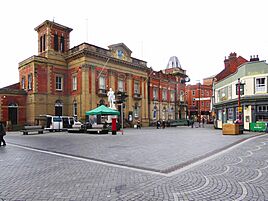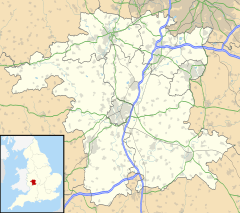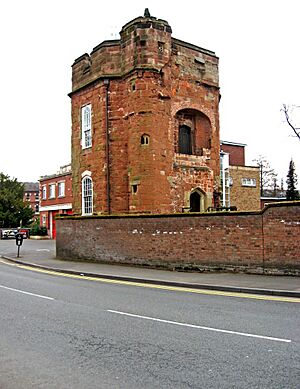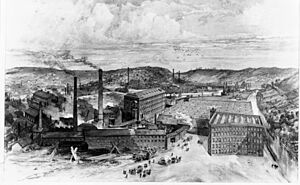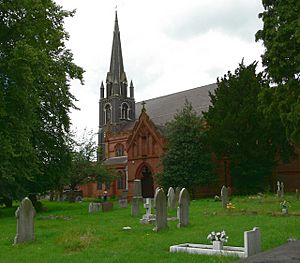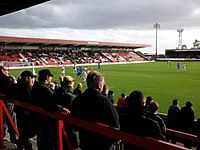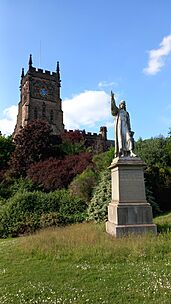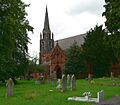Kidderminster facts for kids
Quick facts for kids Kidderminster |
|
|---|---|
|
Clockwise, from top:Town centre, with the Town Hall, fronted by a statue of Sir Rowland Hill; Slingfield Mill Chimney; St Mary and All Saints' Church seen from the Staffordshire and Worcestershire Canal |
|
| Area | 16.25 km2 (6.27 sq mi) |
| Population | 57,400 (2021) |
| • Density | 3,532/km2 (9,150/sq mi) |
| OS grid reference | SO831767 |
| • London | 131 miles (211 km) SE |
| Civil parish |
|
| District |
|
| Shire county | |
| Region | |
| Country | England |
| Sovereign state | United Kingdom |
| Post town | KIDDERMINSTER |
| Postcode district | DY10, DY11 |
| Dialling code | 01562 |
| Police | West Mercia |
| Fire | Hereford and Worcester |
| Ambulance | West Midlands |
| EU Parliament | West Midlands |
| UK Parliament |
|
| Website | Kidderminster Town Council |
Kidderminster is a busy town in Worcestershire, England. It is about 20 miles (32 km) southwest of Birmingham and 12 miles (19 km) north of Worcester. The town is located north of the River Stour and east of the River Severn. In 2021, about 57,400 people lived there. Kidderminster is also twinned with Husum, Germany.
The town is in the very north of Worcestershire. Its northern parts are only a few miles from the borders of Staffordshire and Shropshire. Kidderminster is the main centre for the larger Wyre Forest District. This area includes the towns of Stourport-on-Severn and Bewdley, plus other smaller places.
Contents
- A Look Back at Kidderminster's History
- Kidderminster's Location
- Economy: The Carpet Town
- Who Lives in Kidderminster?
- Buildings and Landmarks
- Getting Around Kidderminster
- Education in Kidderminster
- Sports in Kidderminster
- Fun Places to Visit
- Local News and Radio
- Kidderminster's Weather
- Famous People from Kidderminster
- Images for kids
- See also
A Look Back at Kidderminster's History
How Kidderminster Got Its Name
The area around Kidderminster might have been first settled by an Anglo-Saxon tribe called the Husmerae. This tribe is mentioned in an old document from 781. It talks about land being given to a bishop, which led to a monastery (or minstre) being built.
The name Kidderminster first appeared in the Domesday Book in 1086. It was written as Chideminstre. This means 'Cydda or Cydela's minster or monastery'. It was a large area owned by William the Conqueror. It included 16 smaller settlements. Over time, the spelling changed until it became Kidderminster by the 1500s.
Early Growth and Industries
Between 1156 and 1162, King Henry II gave the land to his steward, Manasser Biset. The settlement grew, and by the 1200s, it had a fair and a market.
To the south, near the River Stour, you can still see one tower of Caldwall Castle. This was a strong house built in the 1400s.
Kidderminster grew a lot because of its early cloth industry. This was helped by its location on the River Stour. It was also at a point where four main roads met. These roads led to Birmingham, Dudley, Worcester, Bewdley, and Bridgnorth. Around 1540, a visitor named John Leland noted that Kidderminster "standeth most by clothing." For centuries, the town was known for weaving, fulling, and milling cloth. Many other trades also thrived here, like shoemaking and dyeing.
Royal Charters and Civil War Times
King Charles I gave Kidderminster a special document called a Charter in 1636. This made it an official Borough. You can still see this original charter at Kidderminster Town Hall.
Kidderminster was important during the English Civil War. This was because of its location where several main roads met. There were a few small battles in and around the town.
In the late 1600s, Kidderminster's cloth industry became even more organised. By 1677, the town had many weavers and spinners. After 1685, many French Protestants called Huguenots came to Britain. They were skilled workers and helped improve the cloth weaving industry in towns like Kidderminster.
The Rise of Carpet Weaving
In the early 1700s, carpet weaving started in Kidderminster. This quickly became the town's main business. It grew even more when the Staffordshire and Worcestershire Canal opened in 1771. Later, the railway arrived in 1852. The carpet industry became less strong in the 1970s, but it still exists today, though on a smaller scale.
In 1828, there were problems with trade. Many looms were not working for a long time. This led to some damage being done in the town.
Modern Local Government
In 1835, Kidderminster's local government changed. It became a municipal borough. The current Town Hall was built in 1877.
Kidderminster has two special churches built in the 1800s. St George's Church was built from 1821 to 1824. St John's Church was built in 1843.
In 1974, the old borough of Kidderminster joined the new Wyre Forest District. In 2015, Kidderminster became a civil parish again. This meant it got a new Town Council after people voted for it.
Kidderminster's Location
The River Stour and the Staffordshire and Worcestershire Canal both flow through the centre of Kidderminster.
 |
Arley, Highley, Alveley, Bridgnorth, Telford | Wolverley, Cookley, Kinver, Enville, Wolverhampton | Blakedown, Hagley, Stourbridge, Dudley, Birmingham |  |
| Bewdley, Ludlow | Belbroughton | |||
| Tenbury Wells, Leominster | Stourport, Hartlebury, Worcester | Bromsgrove, Droitwich |
Economy: The Carpet Town
The modern carpet industry started in Kidderminster in 1785 with a company called Brintons. The carpet industry became very important for the town's economy. The local newspaper is even called The Shuttle. This name comes from the shuttles used on carpet looms.
A special type of carpet was known as Kidderminster carpet. It was reversible and had no pile. The pattern showed in different colours on each side. This carpet was popular from the 1700s to the early 1900s. By 1951, there were over thirty carpet makers in the town.
In 2012, a museum opened in Kidderminster. It is all about the town's history with carpets.
Who Lives in Kidderminster?
In 2011, there were 55,530 people living in Kidderminster. Most residents were White (96.8%). The largest non-white groups were Asian (1.7%) and mixed race (1.2%).
Most people in Kidderminster (67%) said they were Christian. About 24.7% said they had no religion. The largest non-Christian groups were Muslims (0.8%) and Buddhists (0.2%).
Buildings and Landmarks
Kidderminster's main church is St Mary and All Saints'. It is a very old building, mostly from the 1400s and 1500s. Another important church is St John's Church, built in 1843. The Town Hall from 1877 is also a notable building.
Many old buildings in Kidderminster were lost from the 1960s onwards. This led to the creation of the Kidderminster Civic Society in 1993. This group works to protect the town's history.
There are some interesting old factory buildings in Kidderminster. Most of them have been changed for other uses. One example is the former Slingfield Mill, built between 1864 and 1870. It has been turned into shops.
A famous expert on buildings, Pevsner, once said Kidderminster was "uncommonly devoid of visual pleasure." Crown House, an office block from the 1970s, was especially disliked. It was even called one of the ugliest buildings in Britain. It was torn down in 2020, which made the town's skyline look better.
Getting Around Kidderminster
Trains
Kidderminster has two train stations very close to each other. The main station, Kidderminster, has trains to Birmingham, Worcester, and London. The other station, Kidderminster Town, is the start of the old Severn Valley Railway. This special railway has trains that run to Bridgnorth.
Roads
Several main roads go through Kidderminster. These include the A456 (from Birmingham), the A451, the A442, and the A449. A big change to the town's roads was building a ring road in the 1970s and 1980s. This helped with traffic but also meant fewer customers for shops in the town centre. The ring road was never fully finished, so it doesn't make a complete circle.
The closest motorway is the M5. You can find signs for Kidderminster from junctions 3 and 6 of the M5.
Canals
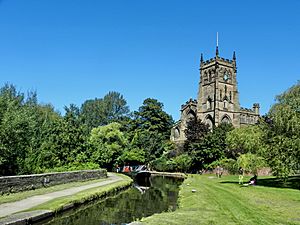
The Staffordshire and Worcestershire Canal also goes through the town.
Buses
You can take direct buses from Kidderminster to towns like Worcester, Halesowen, Bewdley, Stourport, and Bridgnorth. Most bus services in Kidderminster are run by Diamond West Midlands.
Education in Kidderminster
Kidderminster's schools have changed from a three-part system (first, middle, and high schools) to a two-part system. Now, there are primary schools and secondary schools, which is more common in the UK. Some schools closed or merged during this change. The three high schools, King Charles I School, Wolverley C E Secondary School, and Baxter College, became secondary schools that include sixth forms (for older students).
Heathfield Knoll School in Wolverley is an independent school. Holy Trinity School became a state-funded free school in 2014. Kidderminster College is located in the town centre. Other local secondary schools are The Stourport High School & VIth Form Centre and The Bewdley School.
Sports in Kidderminster
Cricket
Kidderminster CC is a local cricket club. The Worcestershire County Cricket Club sometimes plays games at their home ground, Chester Road North Ground.
Football
Kidderminster Harriers F.C. is the town's professional football club, started in 1886. Their local rivals used to be Worcester City and Bromsgrove Rovers. More recently, they have played against Cheltenham Town and Hereford United.
In 2000, the Harriers reached the Football League. They were the only team from Worcestershire to do so. In 1994, they beat Birmingham City in the FA Cup. They almost reached the quarter-finals, losing to Premier League side West Ham United 0-1.
Recently, Kidderminster has had some success under manager Russell Penn. In the 2021–2022 season, they had a great FA Cup run. They played against West Ham again, losing 1-2. This game brought a lot of money to the club. In the 2022–2023 season, Kidderminster won their Play-Offs and moved up to the National League.
The Kidderminster & District League has been running since 1984. It includes teams from Worcestershire and South Staffordshire.
Rugby
Kidderminster Carolians RFC is a local rugby union club. They have several senior teams, a team for younger players (U18s), and a growing women's team. They also have many mini and junior teams.
Hockey
Kidderminster Hockey club started in 1892. In 2010, they had five men's hockey teams, a women's team, and a junior team.
Fun Places to Visit
Kidderminster is home to the Severn Valley Railway, a special heritage railway. The Museum of Carpet, which opened in 2012, shows how important the carpet industry was to the town.
Brinton Park is a large urban park south of the town centre. It has 30 acres (12 ha) of land given by John Brinton in the 1880s. Another green space is Wilden Marsh, a nature reserve covering 94 acres (38 ha).
Places of interest near Kidderminster include the West Midlands Safari Park. This is to the west of Kidderminster, towards Bewdley. A few miles south is Hartlebury Castle, which has the Worcestershire County Museum. To the north are the Drakelow Tunnels, an old underground military complex with a museum.
Local News and Radio
The local newspapers for Kidderminster are The Shuttle and the Kidderminster Standard.
Local news and TV shows are provided by BBC West Midlands and ITV Central.
The Wyre was Kidderminster's first local radio station, starting in 2005. Other radio stations that cover the area include Hits Radio Herefordshire & Worcestershire and BBC Hereford & Worcester. The Wyre stopped broadcasting in 2012. Now, Greatest Hits Radio Herefordshire and Worcestershire broadcasts in the area.
Kidderminster's Weather
Kidderminster is known for its unusually high record low temperatures. For example, in July, the temperature has never dropped below 5°C, even though the average low is 11.7°C.
| Climate data for Kidderminster | |||||||||||||
|---|---|---|---|---|---|---|---|---|---|---|---|---|---|
| Month | Jan | Feb | Mar | Apr | May | Jun | Jul | Aug | Sep | Oct | Nov | Dec | Year |
| Record high °C (°F) | 18.0 (64.4) |
19.6 (67.3) |
25.0 (77.0) |
26.6 (79.9) |
28.2 (82.8) |
32.0 (89.6) |
34.6 (94.3) |
32.0 (89.6) |
27.6 (81.7) |
27.0 (80.6) |
18.0 (64.4) |
19.1 (66.4) |
34.6 (94.3) |
| Mean daily maximum °C (°F) | 6.8 (44.2) |
7.4 (45.3) |
10.2 (50.4) |
13.3 (55.9) |
16.8 (62.2) |
19.5 (67.1) |
21.8 (71.2) |
21.4 (70.5) |
18.3 (64.9) |
14.0 (57.2) |
9.7 (49.5) |
7.0 (44.6) |
13.9 (56.9) |
| Mean daily minimum °C (°F) | 1.3 (34.3) |
0.8 (33.4) |
2.7 (36.9) |
3.9 (39.0) |
6.7 (44.1) |
9.7 (49.5) |
11.7 (53.1) |
11.6 (52.9) |
9.5 (49.1) |
6.7 (44.1) |
3.7 (38.7) |
1.5 (34.7) |
5.8 (42.5) |
| Record low °C (°F) | −8.0 (17.6) |
−11.9 (10.6) |
−7.0 (19.4) |
−3.0 (26.6) |
0.0 (32.0) |
2.0 (35.6) |
5.0 (41.0) |
6.0 (42.8) |
−6.0 (21.2) |
−3.0 (26.6) |
−7.0 (19.4) |
−10.1 (13.8) |
−11.9 (10.6) |
| Average rainfall mm (inches) | 65.6 (2.58) |
46.1 (1.81) |
53.1 (2.09) |
62.0 (2.44) |
56.7 (2.23) |
59.1 (2.33) |
54.8 (2.16) |
64.4 (2.54) |
62.9 (2.48) |
80.8 (3.18) |
72.4 (2.85) |
73.3 (2.89) |
751.2 (29.58) |
| Average rainy days (≥ 1.0 mm) | 12.5 | 9.6 | 11.0 | 10.5 | 10.4 | 9.7 | 9.4 | 9.8 | 9.6 | 12.0 | 12.0 | 11.8 | 128.3 |
| Mean monthly sunshine hours | 53.4 | 73.6 | 109.2 | 151.6 | 190.8 | 191.3 | 200.7 | 186.0 | 140.4 | 107.1 | 62.4 | 46.7 | 1,513.2 |
| Source 1: Met Office | |||||||||||||
| Source 2: MyWeather2.com | |||||||||||||
Famous People from Kidderminster
Many interesting people have connections to Kidderminster:
- Richard Baxter: A famous minister who worked in Kidderminster for 19 years starting in 1641. There is a statue of him outside St Mary's church.
- Edward Bradley: A funny writer from the Victorian era, born in Kidderminster in 1827.
- Sammi Davis: A film actress who was born in Kidderminster.
- Tony De Vit: A well-known DJ and singer, born in Kidderminster.
- Alun Evans: The first English football player to be sold for £100,000 as a teenager. He was born here.
- Ukawsaw Gronniosaw: An African prince and former slave who lived in Kidderminster. He wrote his life story here, which was the first autobiography by a Black African published in Britain.
- Robert Hamer: A film director known for his 1949 comedy Kind Hearts and Coronets. He was born in Kidderminster.
- Sir Rowland Hill: He invented the Penny Black stamp and the modern postal system. He was born in Kidderminster. There is a statue of him outside the town hall.
- Iskra Lawrence: A model who grew up in Kidderminster.
- Rustie Lee: A TV personality and chef who used to live near the town.
- Sir Josiah Mason: A pen-maker born in Kidderminster.
- Walter Nash: A former Prime Minister of New Zealand, born in the town.
- James O'Brien: A radio talk show host and journalist who grew up in Kidderminster.
- Robert Plant: The lead singer of the famous 1970s rock band Led Zeppelin. He grew up in Kidderminster.
- Dr Richard Taylor: A Member of Parliament for Wyre Forest from 2001 to 2010. He worked as a doctor at Kidderminster General Hospital.
- Tom Watson: A former Member of Parliament and Deputy Leader of the Labour Party. He went to King Charles I High School in Kidderminster.
Sports Personalities
- Mo Anthoine: A skilled mountain climber born and raised in Kidderminster.
- Peter Collins: A former Formula One racing driver born in Kidderminster. He won 3 Grand Prix races before his career ended in an accident in 1958.
- Kevin Keelan: A footballer who played for Norwich City.
- Melissa Lawley: A forward for Liverpool F.C. Women.
- John Wyer: Born in Kidderminster, he became a manager who led teams to win the Le Mans 24 hours race many times.
Images for kids
-
St Mary's and All Saints Parish Church, seen from the Staffordshire and Worcestershire Canal
-
Aggborough is the home ground of the professional club Kidderminster Harriers, formerly of the Football League.
See also
 In Spanish: Kidderminster para niños
In Spanish: Kidderminster para niños


